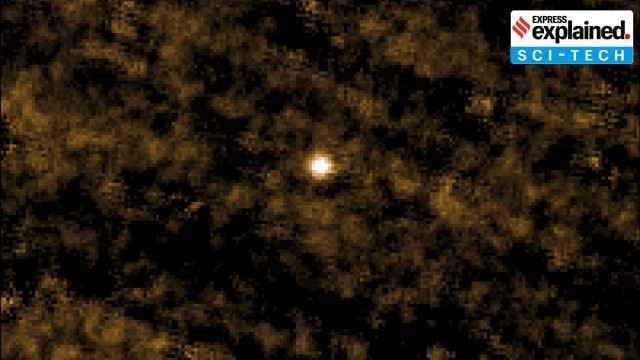Description

Source: IndianExpress
Disclaimer: Copyright infringement not intended.
Context
- Astronomers are waiting for the fiery explosion of T Coronae Borealis, also dubbed the “Blaze Star” and known to astronomers as “T CrB”.
- It is expected to happen in September when a once-in-a-lifetime nova explosion 3,000 light-years from Earth will light up our night sky.
Details
T Coronae Borealis
- T Coronae Borealis (T CrB) is a binary star system located approximately 3,000 light-years away from Earth in the constellation Northern Crown (Corona Borealis).
- It is known for its recurrent nova explosions, making it a significant object of study in astronomy.
Binary Star System
- Components:
- White Dwarf:The primary star, a dense remnant of a larger star, about the size of Earth but with the mass of the Sun.
- Red Giant:The secondary star, nearing the end of its life cycle, losing hydrogen to the gravitational pull of the white dwarf.
Recurrent Nova Phenomenon
- Nature:T CrB is classified as a recurrent nova, which means it undergoes periodic nova explosions.
- Cycle:It erupts roughly every 80 years, with significant recorded events in 1866, 1946, and expected again around September 2024.
- Cause:The white dwarf accretes material from its companion star, leading to periodic thermonuclear explosions on its surface.
Historical Observations
- First Recorded Event:Historical records suggest sightings of T CrB's nova event dating back to 1866, with earlier possible sightings in 1217 and 1787.
- Astronomical Significance:These events have been noted for centuries, contributing to our understanding of stellar evolution and cataclysmic variables.
Nova Explosion Characteristics
- Appearance:During a nova explosion, T CrB significantly increases in brightness, sometimes becoming visible to the naked eye as a "new star" in the sky.
- Duration:The nova event typically lasts for several days, during which time the star's luminosity rises dramatically.
- Post-Eruption:After the event, T CrB returns to its normal brightness until the next eruption cycle begins.
Observational Details
- Location:Found within the Northern Crown constellation, west of the Hercules constellation.
- Visibility:Observable from the Northern Hemisphere during clear nights, particularly in September when the next eruption is expected.

Nova Explosion
- A nova explosion is a sudden, dramatic increase in the brightness of a star, creating a temporary new star visible in the night sky.
- This phenomenon occurs in binary star systems where one star, typically a white dwarf, accretes material from its companion star, leading to a thermonuclear runaway on the surface of the white dwarf.
Mechanism
- Binary Star System:Consists of a white dwarf (primary star) and a companion star (often a red giant).
- Accretion Process:The white dwarf pulls material from its companion due to gravitational attraction.
- Hydrogen Accumulation:Hydrogen-rich material accumulates on the surface of the white dwarf.
- Thermonuclear Reaction:When enough material accumulates, the pressure and temperature on the white dwarf's surface trigger a runaway fusion reaction of hydrogen into helium.
Characteristics of a Nova Explosion
- Brightness Increase:The star's luminosity can increase by up to 100,000 times its normal brightness.
- Duration:The nova event typically lasts for several days to weeks as the hydrogen is consumed in the fusion reaction.
- Visible Spectra:Novae emit spectra characterized by strong hydrogen lines (Balmer series) due to the hydrogen fusion process.
Difference Between Nova and Supernova
- Nova:Involves a white dwarf star and does not destroy the star. It's a recurring event.
- Supernova:Occurs in massive stars, leading to their destruction in a cataclysmic explosion. It's a one-time event resulting in the formation of a neutron star or black hole.
Sources:
IndianExpress
|
PRACTICE QUESTION
Q: With reference to supernovae, consider the following statements:
- Type Ia supernovae occur in binary systems where a white dwarf accretes matter from a companion star until it reaches the Chandrasekhar limit, leading to a thermonuclear explosion.
- Type II supernovae result from the core collapse of massive stars (greater than 8 times the mass of the Sun) after they have exhausted their nuclear fuel.
- Both Type Ia and Type II supernovae leave behind a neutron star or a black hole as a remnant.
Which of the statements given above is/are correct?
a) 1 only
b) 1 and 2 only
c) 2 and 3 only
d) 1, 2, and 3
Answer: b)
|











